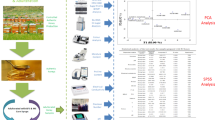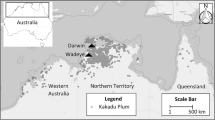Abstract
In this study, six domestic (“Alyanak,” “Hacıhaliloğlu,” “Hasanbey,” “Kabaaşı,” “Sakıt,” and “Soğancı”) and four foreign apricot cultivars (“Bebeco,” “Paviot,” “Colomer,” and “Tyrinthe”) were investigated. All cultivars were collected from the collection orchard of Yuzuncu Yıl University in Van province, Turkey. Fruit biochemicals such as sugars, organic acids, and phenolic compounds were determined. The biochemical composition from ten samples obtained from domestic and foreign apricot cultivars was classified with multivariate analysis (principal component analysis [PCA] and hierarchical cluster analysis [HCA]) based on their sugar, organic acid, and phenolic compositions. Sucrose was the most abundant sugar in all cultivars, and “Hasanbey” had the highest sucrose. “Bebeco” comprised the group with the highest malic acid content. Chlorogenic acid, protocatechuic acid, caffeic acid, ferulic acid, and gallic acid were higher in the domestic cultivars and “Sakıt” and “Soğancı” were the richest in terms of these substances. On the other hand, p‑coumaric acid, o‑coumaric acid, catechin, syringic acid, vanillic acid, and phloridzin were higher in the foreign cultivars, where “Paviot,” “Bebeco,” and “Colomer” came to the fore.
According to the PCA and HCA results, the domestic and foreign cultivars were clustered into two main groups, and the “Bebeco,” “Colomer,” and “Tyrinthe” from foreign cultivars were in the sub-group of the second main group. These results could help plan future breeding programs and determine the fruit quality and nutritional content of domestic and foreign apricot cultivars’.



Similar content being viewed by others
References
Akın EB, Karabulut İ, Topçu A (2008) Some compositional properties of main Malatya apricot (Prunus armeniaca L.) cultivars. Food Chem 107:939–948
Bevilacqua AE, Califano AN (1989) Determination of organic acids in dairy products by high performance liquid chromatography. J Food Sci 54:1076–1079
Cemeroğlu B (2007) Gıda Analizleri. Gıda Teknolojisi Derneği Yayınları. No. 34. Ankara, pp 168–171
Dragovic-Uzelac V, Levaj B, Mrkic V, Bursac D, Boras M (2007) The content of polyphenols and carotenoids in three apricot cultivars depending on stage of maturity and geographical region. Food Chem 102:966–975
Drogoudi PD, Vemmos S, Pantelidis G, Petri E, Tzoutzoukou C, Karayiannis I (2008) Physical characters and antioxidant, sugar, and mineral nutrient contents in fruit from 29 apricot (Prunus armeniaca L.) cultivars and hybrids. J Agr Food Chem 56:10754–10760
Fan X, Zhao H, Wang X, Cao J, Jiang W (2017) Sugar and organic acid composition of apricot and their contribution to sensory quality and consumer satisfaction. Sci Hortic 225:553–560
FAO (2019) FAO statistical database. http://www.fao.org/faostat/en/#data/QC/visualize. Accessed: 18 August 2020
Glew RH, Ayaz FA, Sanz C, Vanderjagt DJ, Huang HS, Chuang LT (2003) Changes in sugars, organic acids and amino acids in medlar (Mespilus germanica L.) during fruit development and maturation. Food Chem 83:363–369
Gurrieri F, Audergon JM, Albagnac G, Reich M (2001) Soluble sugars and carboxylic acids in ripe apricot fruit as parameters for distinguishing different cultivars. Euphytica 117:183–189
Hacıseferoğulları H, Gezer İ, Özcan MM, Asma BM (2007) Post harvest chemical and physical-mechanical properties of some Apricot cultivars cultivated in Turkey. J Food Eng 79:364–373
Hegedũs A, Engel R, Abrankó L, Balogh E, Blázovics A, Hermán R, Halász J, Ercisli S, Pedryc A, Stefanovitsbányai E (2010) Antioxidant and antiradical capacities in apricot (Prunus armeniaca L.) fruits: Variations from genotypes, years, and analytical methods. J Food Sci 75:722–730
Kafkaletou M, Kalantzis I, Karantzi A, Christopoulos VM, Tsantili E (2019) Phytochemical characterization in traditional and modern apricot (Prunus armeniaca L.) cultivars-nutritional value and its relation to origin. Sci Hortic 253:195–202
Kan T, Gundogdu M, Ercisli S, Muradoglu F, Celik F, Gecer MK, Kodad O, Zia-Ul-Haq M (2014) Phenolic compounds and vitamins in wild and cultivated apricot (Prunus armeniaca L.) fruits grown in irrigated and dry farming conditions. Biol Res 47:46
Karabulut I, Bilenler T, Sislioğlu K, Gokbulut I, Ozdemir IS, Seyhan F, Ozturk K (2018) Chemical composition of apricots affected by fruit size and drying methods. Dry Technol 36:1937–1948
Madrau M, Piscopo A, Sanguinetti A, Del Caro A, Poiana M, Romeo F, Piga A (2009) Effect of drying temperature on polyphenolic content and antioxidant activity of apricots. Eur Food Res Technol 228:441–448
Melgarejo P, Salazar DM, Artes F (2000) Organic acids and sugars composition of harvested pomegranate fruits. Eur Food Res Tech 211:185–190
Melgarejo P, Calín-Sánchez A, Carbonell-Barrachina AA, Martínez-Nicolás JJ, Legua P, Martínez R, Hernández F (2013) Antioxidant activity, volatile composition and sensory profile off our new very-early apricots (Prunus armeniaca L.). J Sci Food Agric 4(94):85–94
Muradoğlu F, Pehluvan M, Gündoğdu M, Kaya T (2011) Physico-chemical characteristics and mineral contents of some apricot (Prunus armeniaca L.) genotypes grown in Iğdır province. Iğdır Univ J Inst Sci Tech 1:17–22
Rasanu N, Magearu V, Matei N, Soceanu A (2005) Determination of vitamin C in different stages of fruits growing. Chimie 14(1-2):167–172
Rodriguez-Delgado MA, Malovana S, Perez JP, Borges T, Garcia-Montelongo FJ (2001) Separation of phenolic compounds by high-performance liquid chromatography with absorbance and fluorimetric detection. J Chromatogr A 912:249–257
Roussos PA, Sefferou V, Denaxa NK, Tsantili E, Stathis V (2011) Apricot (Prunus armeniaca L.) fruit quality attributes and phytochemicals under different crop load. Sci Hortic 129:472–478
Ruiz D, Egea J (2008) Phenotypic diversity and relationships of fruit quality traits in apricot (Prunus armeniaca L) germplasm. Euphytica 163:143–158
Ruiz D, Egea J, Gil MI, Tomás-Barberán FA (2005) Characterization and quantitation of phenolic compounds in new apricot (Prunus armeniaca L.) varieties. J Agric Food Chem 53:9544–9552
Schmitzer V, Slatnar A, Mikulic-Petkovsek M, Veberic R, Krska B, Stampar F (2011) Comparative study of primary and secondary metabolites in apricot (Prunus armeniaca L.) cultivars. J Sci Food Agric 91:860–866
Vega-Gálvez A, Quispe-Fuentes I, Uribe E, Martinez-Monzo J, Pasten A, Lemus-Mondaca R (2019) Bioactive compounds and physicochemical characterization of dried apricot (Prunus armeniaca L.) as affected by different drying temperatures. CyTA J Food 17(1):297–306
Yıldız F (1994) New Technologies in apricot processing journal of standard. Apricot special ıssue. Ankara, pp 67–69
Acknowledgements
This manuscript consists of a part of the M.Sc. thesis of Utku Kayakeser and the work was financially supported by Yuzuncu Yıl University, Scientific Research Projects (Project No. 2014-FBE-YL 129).
Author information
Authors and Affiliations
Corresponding author
Ethics declarations
Conflict of interest
F. Muradoglu and U. Kayakeser declare that they have no competing interests.
Rights and permissions
About this article
Cite this article
Muradoglu, F., Kayakeser, U. Multivariate Analysis of Turkish and Foreign Apricot Cultivars Based on Biochemical Components. Erwerbs-Obstbau 64, 639–646 (2022). https://doi.org/10.1007/s10341-022-00718-2
Received:
Accepted:
Published:
Issue Date:
DOI: https://doi.org/10.1007/s10341-022-00718-2




